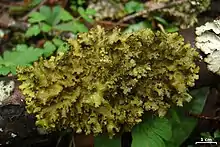Tuckermannopsis
Tuckermannopsis is a genus of foliose lichens in the family Parmeliaceae.
| Tuckermannopsis | |
|---|---|
 | |
| Tuckermannopsis ciliaris | |
| Scientific classification | |
| Domain: | Eukaryota |
| Kingdom: | Fungi |
| Division: | Ascomycota |
| Class: | Lecanoromycetes |
| Order: | Lecanorales |
| Family: | Parmeliaceae |
| Genus: | Tuckermannopsis Gyeln. (1933) |
| Type species | |
| Tuckermanopsis ciliaris (Ach.) Gyeln. (1933) | |
Taxonomy
The genus was circumscribed in 1933 by Hungarian lichenologist Vilmos Kőfaragó-Gyelnik. The genus name of Tuckermannopsis was in honour of Edward Tuckerman (1817–1886), who was an American botanist and professor who made significant contributions to the study of lichens and other alpine plants. He was a founding member of the Natural History Society of Boston and most of his career was spent at Amherst College.[1]
Tuckermanopsis ciliaris was assigned as the type, and at that time, only species.[2] The type species is a cetrarioid lichen, meaning it is erect, foliose, and with apothecia and pycnidia (sexual and asexual reproductive structures, respectively) that are largely restricted to the margins of the lobes. Starting in the 1980s, the genus became a wastebasket taxon containing cetrarioid species of uncertain taxonomic affinities.[3] In 2001, Ingvar Kärnefelt and Arne Thell attempted to delimit Tuckermannopsis based on a combination of morphology and molecular phylogeny, although the DNA of only four species was used in the analysis. They accepted seven species in the genus, with distribution centres in western North America and Japan.[4]
In 2017, Divakar and colleagues used a recently developed "temporal phylogenetic" approach to identify temporal bands for specific taxonomic ranks in the family Parmeliaceae, suggesting that groups of species that diverged within the time window of 29.45–32.55 million years ago represent genera. They proposed to synonymize Tuckermannopsis (and several other cetrelioid genera) with Nephromopsis, so that all the genera within the Parmeliaceae are about the same age.[5] Although some of their proposed taxonomic changes were accepted, the synonymization of the cetrelioid genera with Nephromopsis was not accepted in a later critical analysis of the temporal phylogenetic technique for use in fungal systematics.[6]
Description
Characteristic of genus Tuckermannopsis include a thallus that is either foliose (leafy) or somewhat fruticose (shrubby) with an upper surface that is brown or greenish in colour; cyclindircal asci with a small tholus (a thickened apical region) and broad axial body; ascospores that are more or less spherical, measuring 4–8 μm in diameter; the absence of the secondary metabolite usnic acid in the cortex, and the presence of various compounds in the medulla.[3]
Species
.jpg.webp)
- Tuckermannopsis americana (Spreng.) Hale (1987)[7]
- Tuckermannopsis aurescens (Tuck.) Hale (1987)[7]
- Tuckermannopsis chlorophylla (Willd.) Hale (1987)[7]
- Tuckermannopsis ciliaris (Ach.) Gyeln. (1933)[2]
- Tuckermannopsis gilva (Asahina) M.J.Lai (1980)[8]
- Tuckermannopsis hengduanensis (X.Q.Gao & L.H.Chen) M.J.Lai & Z.G.Qian (2007)
- Tuckermannopsis merrillii (Du Rietz) Hale (1987)[7]
- Tuckermannopsis microphyllica (W.L.Culb. & C.F.Culb.) M.J.Lai (1980)[8]
- Tuckermannopsis orbata (Nyl.) M.J.Lai (1980)[8]
- Tuckermannopsis subalpina (Imshaug) Kärnefelt (1993)[9]
- Tuckermannopsis ulophylloides (Asahina) M.J.Lai (1980)[8]
- Tuckermannopsis weii (X.Q.Gao & L.H.Chen) Randlane & Saag (2003)[3]
The lichen once called Tuckermannopsis inermis (Nyl.) Kärnefelt (1993) has been transferred to genus Melanohalea, as Masonhalea inermis. T. coralligera (W.A.Weber) W.A.Weber (1991)[10] and T. fendleri (Nyl.) Hale (1987)[7] have been moved to genus Tuckermanella, created in 2003 to contain cetrarioid lichens previously placed in the "Cetraria fendleri" species group.[11]
References
- Burkhardt, Lotte (2022). Eine Enzyklopädie zu eponymischen Pflanzennamen [Encyclopedia of eponymic plant names] (pdf) (in German). Berlin: Botanic Garden and Botanical Museum, Freie Universität Berlin. doi:10.3372/epolist2022. ISBN 978-3-946292-41-8. S2CID 246307410. Retrieved January 27, 2022.
- Gyelnik, V. (1933). "Lichenes varii novi criticique". Acta Fauna Flora Univ. II. Bot. 1: 3–10.
- Randlane, Tiina; Saag, Andres (2003). "Taxonomic notes on some cetrarioid lichens". Mycotaxon. 87: 479–487.
- Kärnefelt, Ingvar; Thell, Arne (2001). "The delimitation of the genus Tuckermannopsis Gyeln. (Parmeliaceae, lichenized Ascomycetes) based on morphology and DNA sequences". In McCarthy, P.M.; Kantvilas, G.; Louwhoff, S.H.J.J. (eds.). Lichenological Contributions in Honour of Jack Elix. Bibliotheca Lichenologica. Vol. 78. Stuttgart/Berlin: J. Cramer. pp. 193–210. ISBN 978-3-443-58057-5. ISSN 1436-1698.
- Divakar, Pradeep K.; Crespo, Ana; Kraichak, Ekaphan; Leavitt, Steven D.; Singh, Garima; Schmitt, Imke; Lumbsch, H. Thorsten (2017). "Using a temporal phylogenetic method to harmonize family- and genus-level classification in the largest clade of lichen-forming fungi". Fungal Diversity. 84: 101–117. doi:10.1007/s13225-017-0379-z. S2CID 40674310.
- Lücking, Robert (2019). "Stop the abuse of time! Strict temporal banding is not the future of rank-based classifications in Fungi (including lichens) and other organisms". Critical Reviews in Plant Sciences. 38 (3): 199–253. doi:10.1080/07352689.2019.1650517. S2CID 202859785.
- Egan, Robert S. (1987). "A fifth checklist of the lichen-forming, lichenicolous and allied fungi of the continental United States and Canada". The Bryologist. 90 (2): 77–173. doi:10.2307/3242609. JSTOR 3242609.
- Lai, Ming Jou (1980). "Studies on the cetrarioid lichens in Parmeliaceae of East Asia (I)". Quarterly Journal of the Taiwan Museum. 33 (3–4): 215–229.
- Kärnefelt, Ingvar; Mattsson, Jan-Eric; Thell, Arne; Karnefelt, Ingvar (1993). "The lichen genera Arctocetraria, Cetraria, and Cetrariella (Parmeliaceae) and their presumed evolutionary affinities". The Bryologist. 96 (3): 394. doi:10.2307/3243869. JSTOR 3243869.
- Egan, Robert S. "Changes to the "Fifth Checklist of the Lichen-Forming, Lichenicolous and Allied Fungi of the Continental United States and Canada." Edition III". The Bryologist. 94 (4): 396–400. doi:10.2307/3243829. JSTOR 3243829.
- Esslinger, T.L. (2003). "Tuckermanella, a new cetrarioid genus in western North America". Mycotaxon. 85: 135–141.